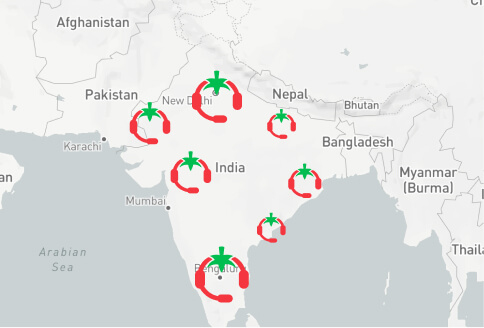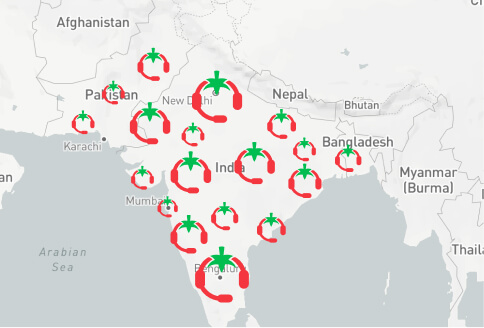How AI will Transform Contact Centers in the Next 5 Years
Learn about Contact Center Trends Shaped by AI

Overview
Given AI’s ability to process and generate language, it is well-suited to improve the core functions of contact centers, across voice, chat, and email communications. By embedding AI into these channels, contact centers can improve customer experiences, augment agents capabilities, and improve overall efficiency.
In this whitepaper, Ofer Ronen, CEO of Tomato.ai, shares three predictions, for senior executives at BPO and enterprise contact centers to consider, on how AI will shape the future of contact centers over the next five years. Then actionable next step are provided to help executives stay ahead of these trends, and their peers.
Ofer is drawing from his extensive experience leading Google’s Contact Center AI initiatives—where he spearheaded Virtual Agents Development, Virtual Agent Analytics, and Agent Assist efforts, and secured over $500 million in deals. He provides valuable insights into the evolving role of practical AI solutions in customer service and sales.
Trend 1
Offshore Agents to Mushroom
Trend 2
Higher Agent Interaction Complexity
Trend 3
Wider Agent Pay Distribution
Offshore Agents to Mushroom
Offshore call centers offer enterprises a compelling option due to their ability to significantly reduce operational costs while providing access to a large pool of skilled agents. These centers are often located in regions with lower labor costs, allowing companies to maintain high service quality at a fraction of the expense. Additionally, offshore centers often provide round-the-clock support, enabling businesses to offer 24/7 service, which can enhance customer satisfaction and loyalty.
Even though offshore English competency is adequate in places like India and The Philippines, where offshoring is often done, there exists a performance gap compared to onshore, which materially impacts performance. In one study customer satisfaction rates for onshore call centers were 81%, while offshore centers scored 62%. Customers generally prefer speaking to onshore agents, so much so that another study asked respondents if they would be willing to use an offshore call center if it meant paying 10% less for the service. Interestingly, three times as many people said they would still prefer an onshore service in such a case.
With the advent of AI offshore contact centers are starting to close the performance gap with onshore, and in the coming years AI will accelerate that trend, and help drive significant growth of offshore call centers.
Access Whitepaper
Get instant access to our exclusive whitepaper
“How AI Will Transform Contact Centers in the Next 5 Years”



Current Contact Center AI tools, such as Agent Assist (real-time help to agents on a turn-by-turn basis), AI Summary (post interaction summary), and AI Insights (post-call suggestions and training), can help offshore agents sound clearer, for example by feeding answers in real-time to agents to read, thereby reducing grammatical mistakes. Also, by providing post call insights into how they can better respond to customers, using specific grammatically correct phrases, and expressions onshore agents are more likely to use.
Nonetheless, these AI solutions have their limitations when it comes to helping offshore agents with their language challenges. They struggle particularly with free-flowing, meandering conversations that can arise during phone calls. Customers tend to be more verbose on calls than in chat or email, which adds complexity to the interactions.
When AI solutions start enabling agents at scale
| 2024 | 2025 | 2026 | 2027 | 2028 | |
|---|---|---|---|---|---|
| Calls |
|
|
|
|
|
| Chat/Email |
|
|
|
*Failed conversations auto detected and proactively have relevant agents re-engage
In the next 5 years a crop of AI tools will emerge that will significantly help offshore agents perform more like their onshore counterparts by directly changing how the agents sound to customers. Such tools include Accent AI (softening accents in real-time), Grammar AI (correcting grammar in real-time), and Translation AI (translating across languages in real-time). They will help agents overcome limitations when communicating in a foreign language.
Once these tools are adopted ubiquitously capable individuals will be able to support customers globally making language limitations less of a factor in hiring, and significantly closing the customer experience gap with onshore agents. The number of offshore agents will grow tremendously, making offshoring call centers more compelling than ever, as they will combine low price points with higher than ever performance. Companies will increasingly be able to leverage lower-cost labor markets without sacrificing customer service quality, leading to a proliferation of affordable offshore contact centers.
In addition, the incorporation of such language proficiency AI tools into offshore call centers will streamline training and onboarding processes. Agents will spend less time taking language and pronunciation classes, and can focus more of their time on serving customers. In addition, contact centers will be able to more fully utilize agents, because each agent will be able to handle interactions across more geographies.
Higher Agent Interaction Complexity
Higher skilled agents will be needed
With the advent of powerful Large Language Models (LLMs), like ChatGPT and Claude, it is easier than ever to automate conversations across channels. Over the coming years an increasing number of simpler interactions will be automated, leaving the more complex ones for human agents to field.

These remaining complex conversations will fall under two broad categories, ones that require more technical expertise, for example technical support, and ones that require more empathy, for example helping an upset customer.
Interaction Complexity Means
More troubleshooting
More expertise
More one-offs
More trust
More feelings
More empathy
These complex issues often require nuanced understanding, critical thinking, and the ability to navigate unpredictable situations. For example, resolving a billing dispute may involve understanding multiple customer touchpoints, corporate policies, and potentially sensitive personal issues. This shift means agents will need to develop a deeper knowledge base and problem-solving skills to address unique customer needs that automated systems cannot fully grasp.
With AI handling transactional and repetitive tasks, the human element of customer support becomes even more critical. Complex interactions often involve emotions like frustration, confusion, or distress, which require empathy and a personal touch. Agents must be trained not only in product knowledge but also in soft skills, such as active listening and emotional intelligence. An empathetic response can significantly impact customer satisfaction, especially in situations where the customer feels vulnerable or misunderstood.
For example, helping a customer navigate a difficult healthcare claim requires both an understanding of the system and the ability to provide reassurance during what may be a stressful time. These human qualities cannot be replicated by AI, making them invaluable in the customer support ecosystem.
As this trend continues, the role of customer support agents will increasingly resemble that of consultants or advisors, rather than just problem solvers. This shift will require organizations to invest even more in continuous training and development for their agents, ensuring they are equipped to handle a wider range of complex and sensitive scenarios. Moreover, agents will need to work closely with AI systems, leveraging data and insights from these tools to inform their decisions and provide more personalized support. In this environment, collaboration between humans and AI will be key, with AI augmenting the agent’s abilities rather than replacing them. This evolution underscores the importance of fostering a culture of empathy and innovation in customer support teams.
Wider Agent Pay Distribution
The net effect of Trend 1: Offshore Agents Mushrooming, and Trend 2: Higher Agent Interaction Complexity, will be a wider agent pay distribution, as a direct result of increased adoption of AI solutions across global call centers. On the left side in the graphic below are onshore agents with more expertise and better soft skills than is standard today, who will command even higher pay than is common today.

On the right side of the graphic above are lower cost offshore agents. Capable agents who would not be hireable today due to their language or accent limitations, will become available for work. The sizable increase in supply of agents, especially in countries where labor costs are traditionally lower, will lead to a significant increase in low affordable agents globally. Offshore agents will take on more routine tasks at lower costs, while onshore agents with specialized skills will earn higher wages, creating a clear divide between affordable offshore roles and well-compensated, expert onshore positions.
In terms of actionable next steps for contact center executives, the recommendation is to first focus on implementing AI to help offshore agents. That includes solutions like Accent AI, Grammar AI, and Translation AI. This will bring the cost down across the bulk of interactions handled by human agents, by moving more interactions to lower cost offshore markets. Then once that is implemented and rolled out at scale, to focus on up-leveling onshore agents by implementing appropriate AI tools and extra training, to enhance their expertise, and to help them better address the needs of high emotion, triggered customers.
Recommendation for Contact Center Executives
Step 1
Move more interactions offshore by implementing Accent AI, Grammar AI, and Translation AI, closing the performance gap with onshore agents
Step 2
Use the offshoring savings to invest in AI and training that up-skills onshore agents to better handle complex interactions
Conclusion
As AI-powered tools improve, offshore contact center agents are expected to handle customer interactions more effectively, leading to significant growth in offshore call centers. Currently, a gap exists between the performance of onshore and offshore agents, with studies showing customer satisfaction rates at 81% for onshore centers compared to 62% for offshore. Despite customer preferences for onshore interactions, advancements in AI tools like Accent AI, Grammar AI, and Translation AI will help offshore agents overcome language and communication barriers, making them more competitive. These tools will allow offshore agents to sound clearer, reduce grammatical mistakes, and perform at a level closer to their onshore counterparts significantly enhancing customer experiences. As these technologies become widely adopted, the global pool of capable, low-cost offshore agents will expand, driving substantial growth in offshore contact centers while maintaining service quality.
Simultaneously, as AI automates simpler tasks, human agents will be left with more complex interactions that require greater expertise and empathy. These challenging conversations often involve technical support or emotionally charged situations, necessitating agents with advanced problem-solving skills and strong emotional intelligence. As a result, onshore agents, who can better navigate these nuanced interactions, with assistance from AI solutions and enhanced training, will become increasingly valuable.
This AI shift will lead to a widening pay distribution in the contact center industry. While offshore agents will handle the majority of basic tasks at lower costs, onshore agents with specialized skills will command higher wages, creating an even more pronounced and distinct bifurcation between low-cost offshore roles and high-paid, expert onshore positions.
Future-Proof Your Contact Center with Accent AI
At Tomato.ai we help contact centers increase their competitive advantage with real-time Accent Softening. This immediately improves performance of offshore agents.

Schedule a demo of the Tomato.ai solution, which softens the accent of offshore agents

